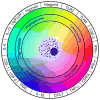Macrophages and therapeutic resistance in cancer
- PMID: 25858805
- PMCID: PMC4400235
- DOI: 10.1016/j.ccell.2015.02.015
Macrophages and therapeutic resistance in cancer
Abstract
How neoplastic cells respond to therapy is not solely dependent on the complexity of the genomic aberrations they harbor but is also regulated by numerous dynamic properties of the tumor microenvironment. Identifying and targeting critical pathways that improve therapeutic efficacy by bolstering anti-tumor immune responses holds great potential for improving outcomes and impacting long-term patient survival. Macrophages are key regulators of homeostatic tissue and tumor microenvironments. Therefore, therapeutics impacting macrophage presence and/or bioactivity have shown promise in preclinical models and are now being evaluated in the clinic. This review discusses the molecular/cellular pathways identified so far whereby macrophages mediate therapeutic responses.
Copyright © 2015 Elsevier Inc. All rights reserved.
Figures



References
-
- Balkwill F. Tumour necrosis factor and cancer. Nat Rev Cancer. 2009;9:361–371. - PubMed
Publication types
MeSH terms
Grants and funding
LinkOut - more resources
Full Text Sources
Other Literature Sources

